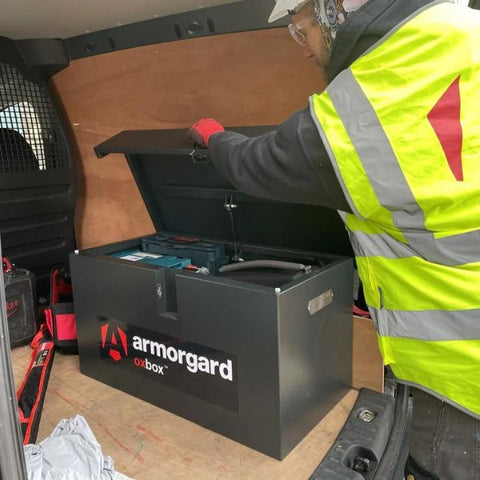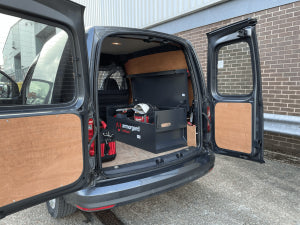Stolen tools are a real headache for those in the construction or facilities industry. While it may seem like a minor inconvenience, it can have serious domino effects throughout companies. Tools on their own are critical assets on any construction site, and having them stolen can produce significant short to long-term setbacks.
Having your tools stolen can result in -
- high replacement costs
- a loss in earnings
- damaged property
- missed project deadlines
It’s not only small tools growing legs – more significant tools like jackhammers, mixers, shovels and more are also being stolen regularly. In addition, materials like loose steel, wood, wiring and more are also stolen.
Why are tools being stolen?
Tools are stolen because they are valuable and incredibly easy to sell quickly. Thieves can usually move the tools swiftly and with little effort – someone is always willing to ‘get a bargain’.
While some contractors are trying to mark their tools with branding or writing, it can usually be removed easily if not done correctly. In some cases, the companies won’t mark the individual tools but will mark the toolbox itself. The problem is that if the toolbox is not secured or is of bad quality, the entire toolset can be stolen quickly.
Popular on-site equipment like chapter-8 barriers or traffic cones are often lifted from sites, especially if they are not marked. Unmarked barriers and cones are hard to trace and could look like they belong to anyone.

How often are tools stolen?
Unfortunately, tools are stolen all too regularly. According to research, vans, trucks and sites are broken into quite regularly across the UK. A Google search of "stolen tools" will show you that there are cases popping up across the country quite often.
How are tools stolen?
Tools are taken from sites in various ways. Most will be lifted from the site if they are not secured or are left unattended for long periods. In more severe cases, vans, trucks or site offices are broken into, and the tools are stolen aggressively.
What happens when tools are stolen?
If your company has ever had tools stolen, you know about the headaches that ensue. The stolen assets will have to be replaced if not found, meaning unexpected costs, which can be pretty expensive depending on what was stolen.
Secondly, missing equipment may result in a loss in earnings for the project. If deadlines are missed or sites experience delays, it may result in fines or the inability to finish projects, depending on the type of equipment stolen.
Lastly, further losses may be incurred where work vehicles, property or other assets have been damaged during a robbery. Stolen tools may affect employee livelihoods and create additional headaches for staff.
The effect of tool theft on an everyday business
Mr Neil Pickford of N. Pickford Installations, one of Pittman's best customers in the UK, has had a fair amount of experience regarding tool theft.
“We’ve unfortunately had a few occurrences of theft over the years. Most recently, we had parked three of our vans and two tippers on site for a job. Unfortunately, the vans were broken into, and we were thoroughly cleaned out of all our tools and equipment. Unfortunately, they took everything we needed for the job, generators etc. All in all, it cost us approximately £10,000 per van to replace the equipment.
In the aftermath, it meant we were scrambling to replace tools as quickly as possible to get jobs done. We have specialised tools that wouldn’t be used as much as others, and it was when we went to new jobs we realised we didn’t have those specialised tools anymore, which caused issues.
We regularly install parking meters and similar car park equipment - the meters were also stolen, and the thieves were looking for cash. It’s probably why you now see so many car parks switching to phone apps and credit card payments instead.
It’s a shame because you must be completely conscious on-site about what you’re doing and where you’re leaving your stuff. Nothing is safe these days. The best thing you can do is deter the thieves as much as possible – lock your equipment up, don’t leave anything lying around, and bolt down any van boxes or tool boxes. We also recently ensured our van’s deadlocks were up to scratch.”
What you can do to prevent tool theft
Prevention is better than the cure when it comes to equipment theft.
- Don’t leave tools unattended
It’s simple, but effective. Prevention Expensive tools should not be left unattended on sites or in open vans or trucks. While most construction sites may be closed off to the public it may not stop some thieves when owners have their back turned.
When tools are not in use be sure to remove them from site and lock them away until needed again. Plant machinery and vehicles should also be locked and secure to stop thieves damaging or interfering with property.
2. Store plant machinery and tools away securely in steel storage boxes
Leaving tools in the backs of vans or trucks is not enough to prevent theft. Consider installing van or truck storage boxes into the work vehicles to provide more secure storage. Most storage boxes can be drilled into place and give companies a long-term solution to tool storage, while also helping with keeping assets organised. The Armorgard® range helps to secure your equipment – the 5-lever deadlocks on most of their box options will stop thieves in their tracks.
It is also recommended that vans are themselves are locked securely. Unlocked or vehicles can invite thieves inside and can see your tools disappear in just a few minutes. Check locks regularly and keep an eye out for parts of doors that may have already been bent or deformed by thieves. Be sure to remind any staff or site employees that equipment should be secured before clocking off at the end of the day.
As a simple solution you can get stickers made for your work vehicles that simply states “tools are not left in this vehicle overnight”. This may seem like a cheap option but it can work, alerting thieves to not waste their time.
Larger pieces of plant machinery should be stored in secure sheds or compounds. Be sure to remove any keys that would gift thieves' entry.

3. Boost local security in the area
Where possible, security measures should be in place across any building site or workplace where plant and tools are being used. CCTV and warning signage can deter thieves from entering the site, and can catch thieves in the act if they feel brave and continue inside anyway. Vehicles can also be equipped with cameras in order to catch thieves in the act.
What’s more, new vehicle apps can alert drivers to interference with their vehicle and can actually immobilise the car or van and prevent whole vehicle theft.
Adding tracking to your equipment can also help you keep an eye on your equipment and where it is at all times. Trucks and vans can also be equipped with additional motion sensors or cameras which may make thieves think twice.
- Mark, brand or engrave your equipment and steel storage boxes
While marking your equipment will not always stop tools from being lifted it may put some thieves off. In any case, branded or marked tools can help you identify your equipment from others, ideal for large building sites where multiple companies are working together.
In case thieves are successful branding can also help you identify materials if they are located or recovered by police later.
Steps you can take in recovering stolen plant or equipment
Sometimes equipment can be stolen even with plenty of measures in place. All may not be lost – there are several steps you can take in recovering your equipment.
1. Note serial numbers from your machinery and equipment
The specific serial numbers from your equipment can help identify them in an instant. Handing these numbers to the police, local merchants, pawn shops or other construction companies can help catch thieves in the act. It may also stop your items being sold quickly before they can be moved on.
Taking photos of your equipment can also help identify your equipment easily. Having photos to hand will not only help to distinguish your tools from others but can also help to maintain a professional inventory.
2. Add GPS tracking to vehicles, steel storage boxes or directly to equipment
GPS trackers are relatively cheap and can help to keep an eye on where your equipment is at all times. Trackers can be placed on the bottom of steel storage boxes or attached to work equipment to see where they go at any time. This can also work well on a daily basis to keep track of your inventory, especially for companies who are working on several sites at once.
3. Check your current insurance policy
Be sure to check your insurance policy when it comes to coverage of stolen work equipment. Every company can be different when it comes to what they will cover. Some may only cover stolen tools or machinery if they were locked up securely, other may not cover anything at all. In some cases companies may be willing to offer cheaper premiums on your equipment if you can provide proof of lockable storage boxes in your vehicle. Check with them to see what you can get back – it may help to replace some equipment quickly or at least cover some of the cost.







